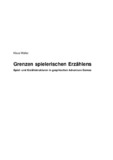Citation link:
https://nbn-resolving.org/urn:nbn:de:hbz:467-2098Files in This Item:
| File | Description | Size | Format | |
|---|---|---|---|---|
| walter.pdf | 2.54 MB | Adobe PDF |  View/Open |
| Dokument Type: | Doctoral Thesis | metadata.dc.title: | Grenzen spielerischen Erzählens : Spiel- und Erzählstrukturen in graphischen Adventure Games | Authors: | Walter, Klaus | Institute: | Fachbereich 3, Sprach-, Literatur- und Medienwissenschaften | Free keywords: | Computerspiel, Medienpädagogik, adventure games | Dewey Decimal Classification: | 793 Spiel | GHBS-Clases: | KLEP | Issue Date: | 2001 | Publish Date: | 2006 | Abstract: | Graphische Adventure Games bilden ein neues medienwissenschaftliches Untersuchungsfeld. An ihnen läßt sich zeigen, wie Spiel und Erzählung miteinander kombiniert werden können und welche Problemfelder sich aus dieser Kombination ergeben. Ziel ist es, die Bauweisen spielerischer bzw. erzählerischer Strukturen zu bestimmen und ihre Veränderungen im Untersuchungszeitraum darzustellen. Adventure Games sind typisch für alle statuarischen interaktiven Medienangebote: Erst wenn eine (spielerische) Entscheidung getroffen worden ist, setzt sich das (narrative) Geschehen fort – ansonsten verharrt es im Stillstand. Spielerische und erzählerische Einheiten wechseln dabei einander permanent ab, weshalb umfassende Zusammenhänge nur begrenzt realisiert werden können. Es ergeben sich besondere Anforderungen für eine dramaturgische Gestaltung. Die Untersuchungsergebnisse zielen deshalb auf eine Optimierung der Adventure Games und ähnlicher Angebote. Die Untersuchung ist von drei analytischen Richtungen bestimmt: ökonomisch, strukturell und historisch. Mittels der ökonomischen Analyse wird der Markt der Computerspiele und ihrer Nutzer dargestellt. Begründungen für die ökonomischen Veränderungen werden aus der Strukturanalyse, in der das Verhältnis von Spiel und Erzählung untersucht wird, abgeleitet. Die Untersuchungsgruppe umfaßt hierfür 24 verschiedene Adventure Games. Für die ökonomische und strukturelle Analyse werden Zeitreihen entwickelt, die einen Zeitraum von 1987 bis 1999 umfassen. Graphical adventure games pose a new field of media scientific research. These media products enable us to show how game and story can be combined and which problems result from this combination. My goal is to show the different structures of game and storytelling elements and to point out their changes during the period of research. Adventure games are typical of all statuaric interactive media formats: The user, by playing, has to make a decision, only then will the narrative events continue – if no decision is made, no further action will occur. Game and story parts permanently take turns, therefore special challenges arise for the dramaturgical design. It is difficult to create broad dramaturgical coherences. Thus the results of the research aims to improve adventure games and comparable media formats. The research takes into account three analytical components: economy, structure and history. An economical analysis shows the market of computer games and their users, whereas a structural analysis shows the relationships between game and story and gives reasons for economical changes. The research sample consists of 24 different adventure games. Economical and structural analyses span a historical period of 13 years (1987 – 1999). |
URN: | urn:nbn:de:hbz:467-2098 | URI: | https://dspace.ub.uni-siegen.de/handle/ubsi/209 | License: | https://dspace.ub.uni-siegen.de/static/license.txt |
| Appears in Collections: | Hochschulschriften |
This item is protected by original copyright |
Page view(s)
827
checked on Nov 23, 2024
Download(s)
864
checked on Nov 23, 2024
Google ScholarTM
Check
Items in DSpace are protected by copyright, with all rights reserved, unless otherwise indicated.

